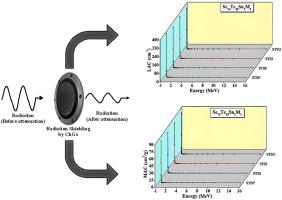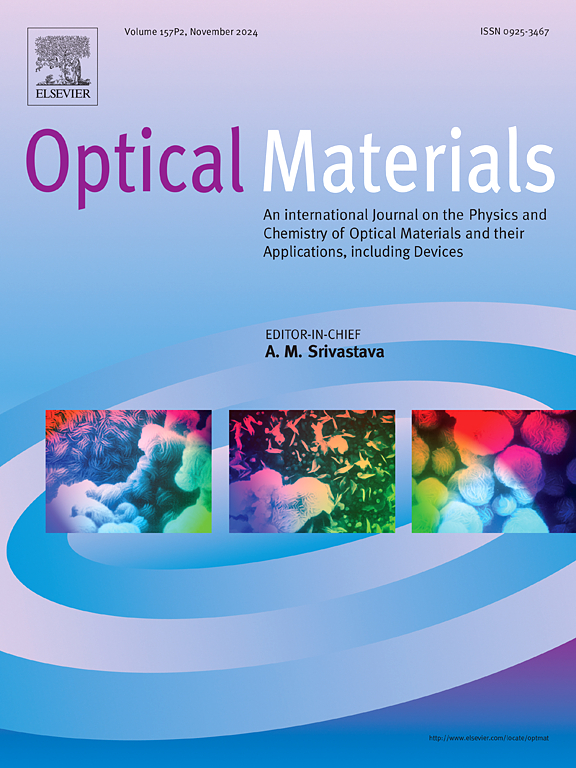用于核废料管理的富含查耳根的四元合金的辐射屏蔽参数综合研究
IF 3.8
3区 材料科学
Q2 MATERIALS SCIENCE, MULTIDISCIPLINARY
引用次数: 0
摘要
本研究探讨了金属添加剂对 Se76Te20Sn2M2(其中 M = Ge、In、Sb 和 Pb)屏蔽特性的影响。这些玻璃可作为屏蔽高能辐射(如 X 射线和ϒ射线)的材料,因为与其他潜在的核安全应用候选材料相比,这些玻璃具有更好的屏蔽参数值。为此,我们使用一个名为 Phy-X/PSD 的在线应用程序计算了各种与辐射有关的防护参数。利用该程序,我们估算出了辐射屏蔽参数的完整列表。我们还讨论了第四种元素 M(M = Ge、In、Sb 和 Pb)对这些参数的影响。半值层(HVL)值在 6 MeV 时达到峰值,锗的半值层达到最大值。Se76Te20Sn2Pb2 和 Se76Te20Sn2Ge2 合金的线性衰减系数(LAC)分别达到最高值和最低值。值得注意的是,Se76Te20Sn2Pb2 合金的有效原子序数(Zeff)、电子密度(Neff)、原子横截面(ACS)和电子横截面(ECS)值最高,表明其屏蔽性能优越。相反,Se76Te20Sn2Ge2 合金的能量吸收积累因子(EABF)和暴露积累因子(EBF)最高。Se76Te20Sn2In2 和 Se76Te20Sn2Pb2 成分的中子衰减效果最好。总体而言,与所研究的其他成分相比,在母玻璃中加入铅的屏蔽能力更强。本文章由计算机程序翻译,如有差异,请以英文原文为准。

A comprehensive study of radiation shielding parameters of chalcogens-rich quaternary alloys for nuclear waste management
The current study examines the impact of metal additives on the shielding characteristics of Se76Te20Sn2M2 (where M = Ge, In, Sb, and Pb). These glasses are useful as shielding materials against high-energy radiation, such as X-rays and ϒ-rays, because these glasses have better values of shielding parameters compared to other potential candidates in the race for nuclear safety applications. To this end, we have calculated various radiation-related protection parameters using an online application called Phy-X/PSD. Using this program, we have estimated a complete list of radiation shielding parameters. The impact of the fourth element M (M = Ge, In, Sb, and Pb) on these parameters is also discussed.
The maximum mass attenuation coefficient (MAC) was recorded at a photon energy of 15 keV for the incorporation of lead. Half-value layer (HVL) values peaked at 6 MeV and it attained its maximum value for germanium. The highest and lowest values of the linear attenuation coefficients (LAC) were obtained for Se76Te20Sn2Pb2 and Se76Te20Sn2Ge2 alloys respectively. Notably, the Se76Te20Sn2Pb2 alloy exhibited the highest values of effective atomic number (Zeff), electron density (Neff), atomic cross-section (ACS), and electronic cross-section (ECS), indicating superior shielding performance. Conversely, energy absorption buildup factors (EABF) and exposure buildup factors (EBF) were highest for Se76Te20Sn2Ge2 alloy. Neutron attenuation was most effective in the Se76Te20Sn2In2 and Se76Te20Sn2Pb2 compositions. Overall, the incorporation of lead in the parent glass demonstrated superior shielding capability compared to the other compositions studied.
求助全文
通过发布文献求助,成功后即可免费获取论文全文。
去求助
来源期刊

Optical Materials
工程技术-材料科学:综合
CiteScore
6.60
自引率
12.80%
发文量
1265
审稿时长
38 days
期刊介绍:
Optical Materials has an open access mirror journal Optical Materials: X, sharing the same aims and scope, editorial team, submission system and rigorous peer review.
The purpose of Optical Materials is to provide a means of communication and technology transfer between researchers who are interested in materials for potential device applications. The journal publishes original papers and review articles on the design, synthesis, characterisation and applications of optical materials.
OPTICAL MATERIALS focuses on:
• Optical Properties of Material Systems;
• The Materials Aspects of Optical Phenomena;
• The Materials Aspects of Devices and Applications.
Authors can submit separate research elements describing their data to Data in Brief and methods to Methods X.
 求助内容:
求助内容: 应助结果提醒方式:
应助结果提醒方式:


